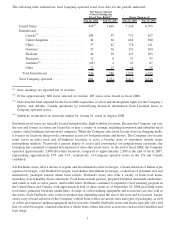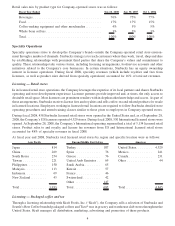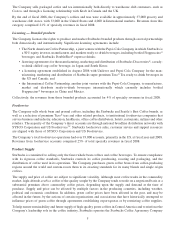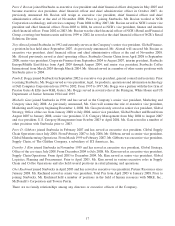Starbucks 2008 Annual Report Download - page 18
Download and view the complete annual report
Please find page 18 of the 2008 Starbucks annual report below. You can navigate through the pages in the report by either clicking on the pages listed below, or by using the keyword search tool below to find specific information within the annual report.•Starbucks faces intense competition in the specialty coffee market.
A description of the general competitive conditions in which Starbucks operates appears on page 7 under
“Competition.” In the United States, the continued focus by one or more large competitors in the quick-service
restaurant sector on selling high-quality specialty coffee beverages at a low cost has attracted Starbucks customers
and could, if the numbers become large enough, adversely affect the Company’s sales and results of operations.
Similarly, continued competition from well-established competitors in international markets could hinder growth
and adversely affect the Company’s sales and results of operations in those markets. Increased competition from
large competitors with significant resources in the United States packaged coffee and tea, and ready-to-drink coffee
beverage market could adversely affect the profitability of the CPG segment and the Company’s results of
operations. Given its premium brand, Starbucks may be impacted more severely than its competitors by customers
trading down to lower priced coffee beverages and related products.
•The Company’s success depends substantially on the value of the Starbucks brand.
Starbucks believes it has built an excellent reputation globally for the quality of its products, for delivery of a
consistently positive consumer experience and for its corporate social responsibility programs. The Starbucks brand
has been highly rated in several global brand value studies. Management believes it must preserve and grow the
value of the Starbucks brand to be successful in the future, particularly outside of North America, where the
Starbucks brand is less well-known. Brand value is based in part on consumer perceptions as to a variety of
subjective qualities. Even isolated business incidents that erode consumer trust, particularly if the incidents receive
considerable publicity or result in litigation, can significantly reduce brand value. Consumer demand for the
Company’s products and its brand equity could diminish significantly if Starbucks fails to preserve the quality of its
products, is perceived to act in an unethical or socially irresponsible manner or fails to deliver a consistently positive
consumer experience in each of its markets.
•The loss of key personnel or difficulties recruiting and retaining qualified personnel could jeopardize the
Company’s ability to meet its financial targets.
The Company’s success depends substantially on the contributions and abilities of key executives and other
employees, and on its ability to recruit and retain high quality employees to work in and manage Starbucks stores.
Starbucks must continue to recruit, retain and motivate management and other employees sufficient to maintain its
current business and support its projected growth. A loss of key employees or a significant shortage of high quality
store employees could jeopardize the Company’s ability to meet its financial targets.
•The Company’s business depends in large part on the success of its business partners and suppliers, and
the Company’s brand and reputation may be harmed by actions taken by third parties that are outside of
the Company’s control.
The Company’s business strategy, including its plans for new stores, foodservice, branded products and other
initiatives, relies significantly on a variety of licensee and partnership relationships, particularly in its International
markets. Licensees are often authorized to use the Starbucks logo and provide Starbucks-branded beverages, food
and other products directly to customers. The Company provides training and support to, and monitors the
operations of, these business partners, but the product quality and service they deliver to Starbucks customers may
be diminished by any number of factors beyond the Company’s control. Management believes customers expect the
same quality of products and service from the Company’s licensees as they do from Starbucks and the Company
strives to ensure customers have the same experience whether they visit a Company-operated or licensed store. Any
shortcoming of a Starbucks business partner, particularly an issue affecting the quality of the service experience or
the safety of beverages or food, may be attributed by customers to Starbucks, thus damaging the Company’s
reputation and brand value and potentially affecting the results of operations.
•Effectively managing the Company’s growth is challenging.
Effectively managing growth can be challenging, particularly as Starbucks expands into new markets interna-
tionally, where it must balance the need for flexibility and a degree of autonomy for local management with
12
























